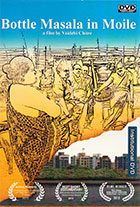
Bottle Masala in Moile 2012
Distributed by Random Frontiers, Vaidehi CHitre, 3402 Edison St., San Mateo, CA 94403, 415-238-2649
Producer n/a
Directed by Vaidehi Chitre
DVD , color, 38 min., English, Marathi, Hindi with English subtitles
College - General Adult
Activism, Anthropology, Building, Catholicism, Cooking, Discrimination, Economics, Food, Future, Geography, Government, History, Postcolonialism, Urban and Regional Planning
Date Entered: 09/01/2015
Reviewed by Linda Frederiksen, Washington State University, Vancouver, WAThe indigenous East Indian population of Mumbai has a rich cultural heritage. Engaged in fishing, farming, ferrying, and other small service industries for centuries, this minority group reflects a Portuguese and Catholic background, with distinctive traditions and beliefs. Bottle masala and moile serve as the title for this short document while also representing two communities threatened by urban growth and expansion.
In Part 1, ruthless land developers are slowly destroying distinctive gaothan hamlets, where East Indians have lived for centuries. Francisca remembers harvesting baskets of sardines from what is now a cement lot; bottle masala entrepreneur Cecelia worked at a 2-rupee job to buy farm land that is quickly disappearing; web designer Prem tries to draw attention to a poor and powerless community that is invisible and disregarded by the government.
Part 2 takes place on Dharavi Island, where Walter and Inas follow ancient traditions of fishing and cooking, including the East Indian dish of moile. Lourdes, Stella, and Rikshala are part of a local women’s collective movement protesting a government project that will destroy their homes, livelihoods, and surrounding environment. The film ends abruptly in 2011 when the Marve-Manori bridge construction is put on hold.
Narrated by those most intimately effected by land reclamation and urban development, filmmaker and blogger Chitre conveys the urgency felt by this marginalized minority in Indian society. Although their story is told with conviction, for viewers unfamiliar with it, the supplementary informational CD or website should be viewed first to appreciate the context of the both the history and conflict. Despite these issues, this is a heartfelt story that is not often told about a population and lifestyle not always acknowledged. Recommended with reservations.